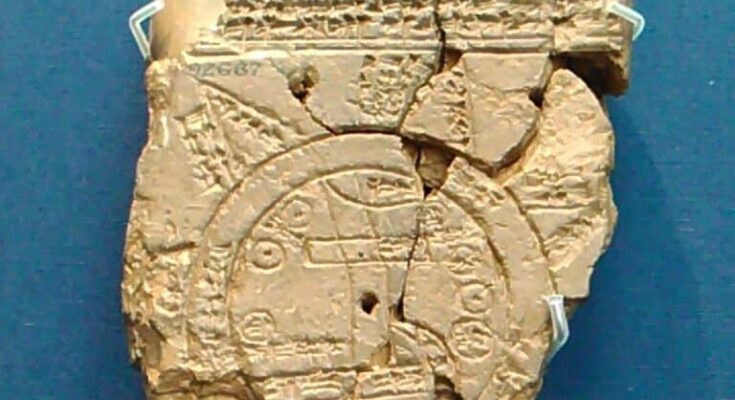
Archeologists have deciphered the world’s oldest map in a Babylonian inscription nearly 3,000 years old and revealed a very familiar story.
A map of Mesopotamia
The “oldest map of the world…in the world” on a Babylonian clay tablet has been deciphered, according to a recent video released by the British Museum.
The plaque from the 6th century BC shows a map of Mesopotamia – roughly where modern-day Iraq is – and what the Babylonians believed lay beyond the then-known world. They discovered the ancient artifact in the Middle East. The British museum acquired it in 1882 but it remained a mystery until recently, when curators found a missing section and transcribed its cuneiform writing.
Beyond a Babylonian world map: Ancient views of Earth
Additionally, the inscription has several paragraphs of cuneiform writing on its back and above the map diagram describing the creation of the Earth and what its author believed existed beyond it.
The map shows Mesopotamia, which the ancient scribe called the “bitter river,” surrounded by a double ring. The river formed the border around the known Babylonian world. Within the bitter river, small circles and rectangles represent various Mesopotamian cities and tribes, including Babylon, while another rectangle represents the Euphrates River.
“You’ve been reduced to this pie chart, the whole known world in which people lived, flourished, and died,” said Dr. Irving Finkel, British Museum curator and cuneiform expert, in the video. “However, there is more to this map than that,” he stressed.
The story of Noah’s Ark in the inscription
“When we operate beyond the known world into fantasy, this inscription becomes essential,” Finkel added. The Babylonian scribe mapped what he believed lay beyond his world. The map included mythical creatures and lands, and a familiar story from ancient history. This story is the Babylonian version of the biblical account of Noah’s Ark.
The ancient Babylonians believed Utnapishtim built a giant ark in 1800 BC. At God’s command, it landed across the bitter river on a mountain. Interestingly, in the Bible narrative this was the same mountain where Noah’s Ark landed. “That’s quite interesting,” Finkel concluded. “Because it shows the story was the same and, of course, that one thing led to another.”
We must note that the ancient Greeks also had their own version of the story. According to the Greek version, the deluge happened at the time when Deucalion reigned in Phthia in Thessaly. Zeus decided to destroy the entire “corrupt” generation of men. The only exception would be the righteous king Deucalion and his wife Pyrrha.



